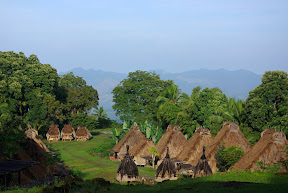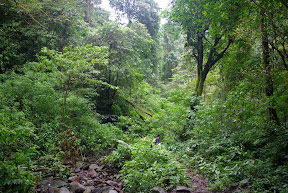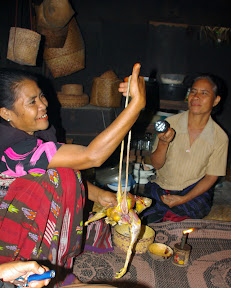
8-9 September 2010
Life in Belaragi, Flores continues pretty much the way it did centuries ago. Houses are made completely of wood, bamboo, and palm. No metal screws or nails are used in construction. Absent also are electricity, telephone lines, television, and many other modern conveniences (and hindrances). If you squint slightly, you are transported back hundreds of years in time. The air is clean, water is clear and abundant, and the pure black night sky escapes light pollution. Belaragi is surrounded by dense rainforest, high forested peaks, distant volcanoes, and from the edge of town you can see the azure Sawu Sea.
We met our guide, William, outside our hotel in Bajawa. After talking to him about hiring a bemo to take us to some of the traditional villages outside of town he mentioned that he was guiding a hike to a remote village near Aimere on the coast the following day. Our interest piqued, he showed us a picture of Belaragi on his cell phone. Immediately, we knew that Belaragi had to be the next destination on our trip across Flores.
Belaragi receives few tourists. It is only reachable by a long, steep hike, and this makes it inaccessible to all but a few intrepid tourists. It is not featured in any guide books, and as far as we know it might not even appear on any maps. William is the only guide who leads trips to Belaragi. He began leading trips to village four years ago, and Rachel and I constituted the eleventh group of tourists (fewer than 30 people total) to visit Belaragi.

The trail to Belaragi starts from William’s house a village on the outskirts of Bajawa. William informed us that the hike is approximately 8 miles and usually takes anywhere from 6 to 12 hours, depending on fitness level, weather, and the trail’s (or lack thereof) condition. As we walked up a moderate incline past tiny old women carrying massive canes of bamboo on their heads or shoulders we hoped that we would not repeat the fate of the only other group of tourists this year and arrive at Belaragi at 9 pm. After an initial incline the trail turns steeply downward. The path is narrow, steep, slick, rocky, and bordered by dense, mostly-untouched rainforest. As a result of the heavy rain the day before, the trail was muddy and slippery in sections. Picking off leeches, at times we felt like we were walking on ice covered with motor oil, and both of us slipped and fell straight on our butts several times-thankfully avoiding injury.

After stopping for lunch at the home of a farmer who lives three hours down the trail, we began to take notice of the dark, thickening clouds that were quickly approaching us and hastily made our way on the progressively overgrown trail. It soon became quite clear that, barring a miracle, the fair weather that had graced the first part of our walk was soon to vanish. With our porter hacking away at the thick grass and fallen tree branches with his parang (machete) the tropical downpour descended upon us. Covering up with rain jackets and stowing everything in plastic bags we were soaked in seconds. Water dripped down our legs and puddled in our shoes. For the next two hours we bushwhacked in the heavy downpour as thunder erupted right above our heads. We crossed flood swollen streams, shin deep, and trudged along the muddy trail, which itself filled with water and flowed with ferocity in sections. Looking like drenched rats, the rain finally abating, we emerged from the rainforest awestruck by Belaragi.
Shedding our packs and wet clothes we became mesmerized by the most beautiful of Ngada traditional villages. Two parallel rows of attractive wooden huts flank the village’s central area, a wide swath of bright green grass between. Words cannot adequately describe Belaragi’s spectacular natural setting, and rarely does one see a man-made settlement that complements its surroundings so gracefully.

Nobody in Belaragi knew we were coming (there are no phones), and, quite frankly, nobody seemed to be moved or impressed by our arrival. There was no fanfare, no weavings shoved in our faces from expectant sellers, no offers of cold Coca Cola’s or snacks. How refreshing! Gradually, word circulated that there were a couple of tourists in town and a few of the villagers came to greet us, and brought us glasses of sweetened, local coffee. The hut where we would spend most of our time was built “several hundred years ago” and consists of a large front porch, a living/sleeping area, and a kitchen. The entry way to the kitchen is surrounded by ornate, symbolic carvings and is deliberately constructed so that you must bow upon entering, in order to show respect to the family’s ancestors. Although Belaragi is officially Catholic we witnessed very few signs of Christianity during our visit. Villagers still ascribe to many traditional, animist beliefs and rituals. Carved, wooden totem-like poles are constructed to honor male ancestors, and small thatched huts pay homage to female ancestors. Figurines and/or small wood houses placed on top of each house symbolize social standing and pay respect to ancestors. Respect for past generations plays prominently in everyday life.

During most of our time in Belaragi we did very little except relax and make small talk (through William and our rudimentary Indonesian) with the villagers. For the first time on this trip we honestly did not feel like tourists. The whole time in Belaragi we felt like welcomed guests-sort of like when visiting the home of a distant relative. The hospitality of the villagers was most apparent at dinner. We sat and watched as dinner was prepared over an open fire inside our hut (no gas or electric stoves here). Preparation commenced with the ritualistic, somewhat gory, sacrifice of a chicken, followed by the burning off of its feathers over the cooking fire. The chicken was then gutted and the entrails were presented to a village elder, her teeth pitted and her mouth stained red from chewing betel nut, for inspection. Over the course of several minutes she examined the chicken’s heart, intestines, and other parts to make sure the sacrifice was successful and that the chicken did not contain any bad omens (like fortune telling via dead chicken). Our chicken having passed the test, dinner was prepared. During the preparations for dinner, a commotion outside the house alerted everyone to the fact that a 1-meter long python had found its way into the covered storage and hen house just outside the back door of the house. The snake was killed and everyone went back inside as dinner was almost ready.

Our meal began with the flinging of rice in the air, and prayers and offerings presented to the ancestors. Rituals completed, we feasted on an ungodly amount of tasty purple colored rice, cassava leaves flavored with papaya flowers and coconut, tasty chicken, chicken juice (a thin, tasteless soup), and a boiled egg for Rachel. Mental note, never finish your glass of chicken juice or it will be refilled. All of this was washed down with copious amounts of arak, a strong, local palm liquor, which superficially resembles weak tequila and makes you grimace and convulse after taking a shot. We talked with the people of the village for a few hours, translating through our guide, and eventually our sleepiness was noticed by the group, who sent us directly to bed. Pumped full of rice and shaken by arak we retired to the sleeping/living room, in the company of several villagers too drunk or stuffed to make it back to their own houses. The combination of the candlelight and quiet chatter and laughter lulled us to sleep after our long day.
The next morning started at dawn with cups of coffee. Sitting outside with several of the villagers, bathed by their constant cigarette smoke, we gazed as the first morning sun hit Belaragi. Breakfast was served several hours later (we are learning true patience here in Indonesia) and consisted of tasty purple rice, boiled cassava, and eggs. We sat on the ground in a circle, as we had at dinner the night before and gave our thanks, through William, to one of the village elders. He wished us happy and safe travels and asked us to come back soon and bring a large group of our friends and family. Any takers back home?
As we said our goodbyes and started our two-hour downhill walk to the bemo awaiting us at the first patch of good road, life continued in Belaragi as it has for centuries. We learned that the money contributed by our visit will help to make improvements to the standard of living in Belaragi. As is the case in many traditional villages across the world, much of the younger generation chooses to live closer to a town where modern amenities, education, and health care are more available. We realize that this beautiful, traditional way of life will disappear if the younger generation chooses to abandon Belaragi. While this is sad, all people deserve access to education and health care. Our great hope is that, someday soon, a school, health clinic, and better road will be built so that future generations will continue to inhabit the homes of their ancestors and call Belaragi home.

Our visit to Belaragi refreshed us and enriched our understanding of Ngada culture. In this world of ever-expanding tourism it is difficult to stray from the beaten path. Down a slippery, muddy trail and through the pouring rain we found a small patch of peace, solitude and authenticity in Belaragi.













